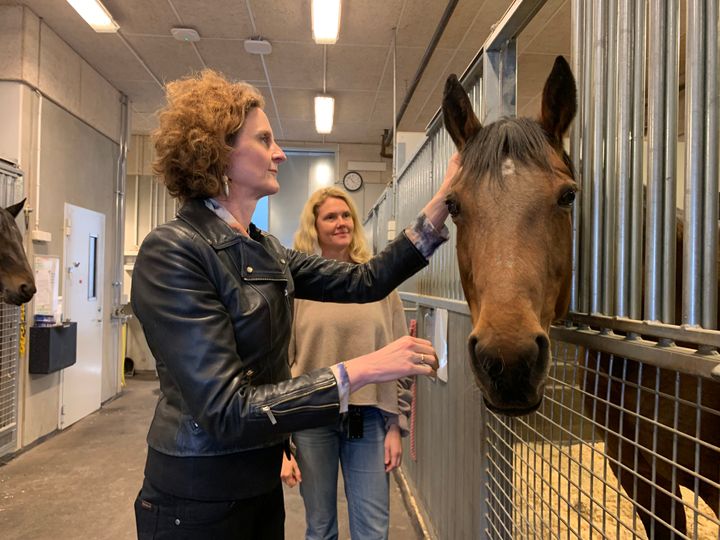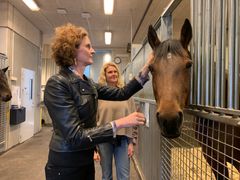AI helps decode horses' body language for better veterinary care
Researchers are using AI to bridge the communication gap between horse and human. Combining 3D motion capture and machine learning, a new modeling system would equip veterinarians with a powerful visual tool for interpreting equine body language—the key to detecting physical and even behavioral problems.

Based on new research from KTH Royal Institute of Technology and Swedish University of Agricultural Science (SLU), the platform can reconstruct the exact 3D motion of horses from videos, using an AI-based parametric model of the horse’s pose and shape. The model is precise enough to enable a veterinarian, for example, to spot telling changes which could otherwise be overlooked or misinterpreted in an examination, such as in a horse’s posture or their body weight.
The system—titled DESSIE—employs disentangled learning, which separates different important factors in an image and helps the AI avoid confusion with background details or lighting conditions, says Hedvig Kjellström, a Professor in computer vision and machine learning at KTH.
“DESSIE marks the first example of disentangled learning in non-human 3D motion models,” Kjellström says.
Elin Hernlund, Associate Professor in biomechanics at SLU and equine orthopedics clinician, says DESSIE would enable greater accuracy in observation and interpretation of horses’ movements and, as a result, earlier and more precise intervention than today. In a sense, it enables getting critical information “straight from the horse’s mouth.”
“Horses are powerful but fragile and they tell us how they are feeling by their body language,” Hernlund says. “By watching their gate we can see, for example, if they are offloading pain,” she says.
“We say we created a digital voice to help these animals break through the barrier of communication between animals and humans. To tell us what they are feeling,” Hernlund says. “It’s the smartest and highest resolution way to extract digital information from the horse’s body—even their faces, which can tell us a great deal.”
The research team are further training DESSIE with images of a wider variety of horse breeds and sizes, which would enable them to link genetics to phenotypes and gain a better understanding of the core biological structure of animals.
“To achieve this, we're asking breeders to send images of their breeds to capture as much variation as possible," Hernlund says.
Images

Subscribe to releases from KTH Royal Institute of Technology
Subscribe to all the latest releases from KTH Royal Institute of Technology by registering your e-mail address below. You can unsubscribe at any time.
Latest releases from KTH Royal Institute of Technology
Study explains why new kinds of steel needed to build lead cooled reactors11.12.2025 14:23:59 CET | Press Release
Safer operation, better fuel efficiency and lower waste mark lead-cooled nuclear power as a potentially dramatic shift from the water-cooled nuclear stations the world has relied on since the mid 20th century. A recent Swedish study casts new light on how to avoid corrosion in the steel used to build these next-generation nuclear facilities.
Alternative to BPA passes toxicity and sustainability standards set by EU innovation guidelines4.12.2025 11:07:37 CET | Press Release
Polyester and a host of other plastic products could potentially be manufactured with non-toxic and sustainable BPA alternatives identified in a multidisciplinary study published today by researchers in Sweden.
Study shows potential for more affordable and efficient hydrogen gas production3.12.2025 15:29:35 CET | Press Release
A recent advance in the science of hydrogen fuel production could enable higher output and more sustainable production of this renewable energy source, researchers with Stockholm’s KTH Royal Institute of Technology report.
Calcium-sensitive switch designed to boost efficacy of cancer drugs24.11.2025 21:11:53 CET | Press Release
Cancer-fighting antibody drugs are designed to penetrate tumor cells and release a lethal payload deep within, but too often they don’t make it that far. A new study shows how this Trojan Horse strategy works better by exploiting calcium differences outside and inside cells.
Potential treatment may prevent brain damage in premature babies11.11.2025 11:10:46 CET | Press Release
A treatment that could protect premature babies from brain damage showed promise in a recent study in Sweden. Using a first-of-its-kind prenatal brain model created with human cells, researchers observed new details about the effects of cerebral hemorrhages on stem cells during premature birth. And they successfully tested an antidote that reduced the damage.
In our pressroom you can read all our latest releases, find our press contacts, images, documents and other relevant information about us.
Visit our pressroom